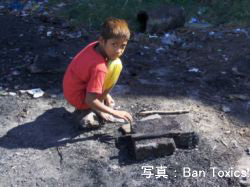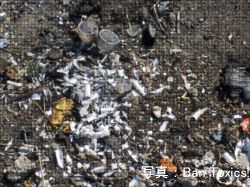Terminal Storage Options of Waste Mercury in the Philippines: Understanding the risks and the political measures required at the municipal and national levels to operationalize terminal storage.
 |
Ban Toxics! |
Report"Terminal Strage Options for Mercury Wastes in the Philippines"[pdf1.1MB] powerpoint"Global Mercury Supply Reduction"[pdf1.1MB] |
 |
Richard Gutierrez | |
 |
http://bantoxics.multiply.com/ | |
 |
JPY 400,000 |
Research Background Final Report (abstract) Others

a child burns electric wires to get the copper

broken compact fluorescent lights
Research Background
Acknowledging the danger posed by mercury, Philippine lawmakers are proposing to pass a law requiring the phase-out of mercury containing products in hospitals and schools. The proposed law, once it passes, will generate large quantities of mercury waste. Unfortunately, the law does not require their permanent retirement or disposal and leaves open how to dispose of the resulting mercury waste without reintroduction into the environment. Without stringent and permanent retirement options, the resulting mercury waste can re-directed by unscrupulous traders and officials to flow to the burgeoning artisanal mining industry in the Philippines, which is one of the main sources of mercury pollution in the country.
The proposed research attempts to address two main questions: what are the environmental risks involved in permanent disposal of mercury and what are the political measures required at the local and national levels to operationalize permanent disposal of mercury wastes.
[June 2008]
Final Report (abstract)
Mercury is one of the most dangerous environmental pollutants, both in its elemental form and in chemical combinations. It is a known neurotoxin and attacks the nervous system. When released into the environment mercury is transformed to its most pernicious form, methyl mercury, which bioconcentrates and bioaccumulates in fish and enters the human body when eaten. The fetus, young children, and pregnant women are most sensitive to the adverse impacts of mercury.
The United Nations Environment Programme has determined that global mercury uses, emissions and releases need to be significantly reduced in order to reduce health and environmental impacts. Armed with this knowledge, countries have begun to take action by setting up standards for maximum content of mercury in food, by restricting the use of mercury and curtailing mercury releases.
Mercury Sources in the Philippines
In 2008 the Philippine Department of Environment and Natural Resources conducted an inventory of mercury sources and releases in the Philippines. The inventory revealed that one major source of mercury emissions, approximately 20% of total, in the Philippines come in the form of wastes from products and processes, e.g. discarded thermometers, batteries, and other mercury-containing devices.
This finding raises additional problems for the Philippines, as it continues to grapple with improper waste disposal. While approximately 5,250 metric tons of waste generated daily in Metro Manila are collected, the remaining 27% of the daily waste or about 1,420 metric tons are dumped illegally on private land, in rivers, creeks, Manila Bay, or openly burned. Although there are laws requiring waste segregation at source, very little segregation happens on the ground.
Assuming that the Philippines is able to sequester some of its mercury contaminated waste; it then faces the prospect of how to manage the mercury so that it does not cycle back into the environment. This study looks into terminal storage, the emerging practice in this field, by placing the captured mercury in a secure and stable facility for perpetuity.
Terminal Storage Options
There are various terminal storage options for mercury around the world, and these options can be viewed in two broad categories: above and below ground. Each broad category has illustrative models, which the study examined: above ground storage- United States Defense National Stockpile Center (DNSC); below ground storage - Germany, landfilling in disused salt mines; below ground storage - Sweden, deep rock injection.
All three options present high technical and financial costs. Site location, geographical stability, hydrology, occurrence of natural disasters, such as hurricanes, are just some of the factors that influenced how these facilities were chosen. Equally, the financial costs are steep for the most part. For deep rock injection, Sweden is expected to incur SEK 200 - 300million (approximately US $ 25 to 37 million) for 1,000 - 20,000 tonnes of high-level mercury waste and the DNSC shelled out US $ 17,450,000 for start-up costs of their facility and is expected to incur at least US $ 547,904 of recurring costs per year to manage 4,436 tons of commodity grade elemental mercury. What appears to be the least expensive is the German salt mines, where the company running the facility is charging 270 EURO per tonne of surplus mercury, mainly from closed chlor-alkali plants.
Gaps in Policy and Law
At the fundamental level, the study examined existing Philippine laws and policy on mercury -whether these are robust and comprehensive enough to support an ambitious project such as terminal storage. The study concludes that at present a comprehensive national policy on mercury that includes and recognizes terminal storage as a key facet in addressing the mercury problem is lacking in the Philippines. Moreover, existing laws, though possessing a range of measures for the establishment of disposal facilities, are inadequate for terminal storage of mercury. The study finds inconsistencies in waste management priorities established by law with respect to mercury wastes, inappropriate exemptions, and weaknesses in the liability regime.[June 2009]
Others
